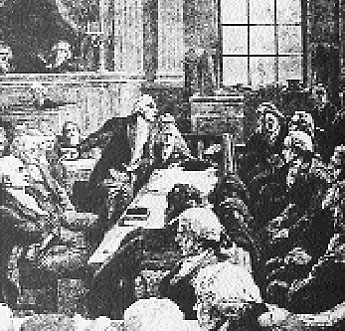The
Kingdom of the Genesee
(continued)
The trial of Aaron
Burr: from the painting by C.W. Jeffreys Burr gave conflicting
accounts of what his intentions were.
The rumors continued
to inflame patriots' suspicions throughout the west. Burr's military force, which
historians estimate at best never totaled more than 30 men, traveled down the
Ohio and Mississippi rivers toward New Orleans. Gen. Wilkinson, who was mentioned
in some of the rumors, panicked and wrote a letter to President Jefferson purporting
to confirm all of the worst allegations against Burr.
Jefferson ordered
Burr's arrest, and he was returned to Richmond for trial on grounds of treason.
The highly publicized trial was presided over by Chief Justice John Marshall.
Despite the best efforts of the prosecutors, a jury found Burr not guilty on all
charges. Harman Blennerhasset was also tried for treason and also won acquittal.
Thus ended one of the most curious episodes in the settling of the American
West. Supporters of the conspiracy theory point to a letter later found in the
British Archives written by Anthony Merry, the British minister to the United
States. The letter, dated Aug. 6, 1804, reports that Charles Williamson had approached
Merry with a plan allegedly at the request of Aaron Burr. The letter claimed
that Burr had offered to “lend his assistance to his Majesty's Government
in any manner in which they might think fit to employ him, particularly in endeavoring
to effect a Separation of the Western Part of the United States from that which
lies between the Atlantik and the Mountains.” Whether this hearsay
account of Burr's plan is accurate, it is known that Williamson later returned
to England and spent many years unsuccessfully trying to raise money to support
Burr's schemes. After Fort Burr was deserted, Abraham Franklin deeded it
to his son, Henry. It was later used as a school house and a church. It burned
in 1826, but was rebuilt the next year. The northern acres were eventually
sold to Josiah Crossman, who gave his name to Crossman's Pond on Fishers Road.
Asa and Elizabeth Gaskil bought the southern portion of the property for farming.
Their daughter, Rebecca, married Charles Fisher. All that remains of Fort
Burr are a few rusted guns, pistols and swords that are occasionally plowed up
in the present Oakbrook subdivision fields off Fisher Road— That and the
spirit of a man who dreamed great dreams. Sheldon Fisher is the
former Ontario County historian and a frequent contributor to Genesee Country
magazine.
4
Back |
Home
According
to WebCounter you are the  person to answer the Clarion Call
person to answer the Clarion Call
©2008 Clarion Publications, Inc. All
Rights Reserved.
This site designed by Clarion Communications. | 
